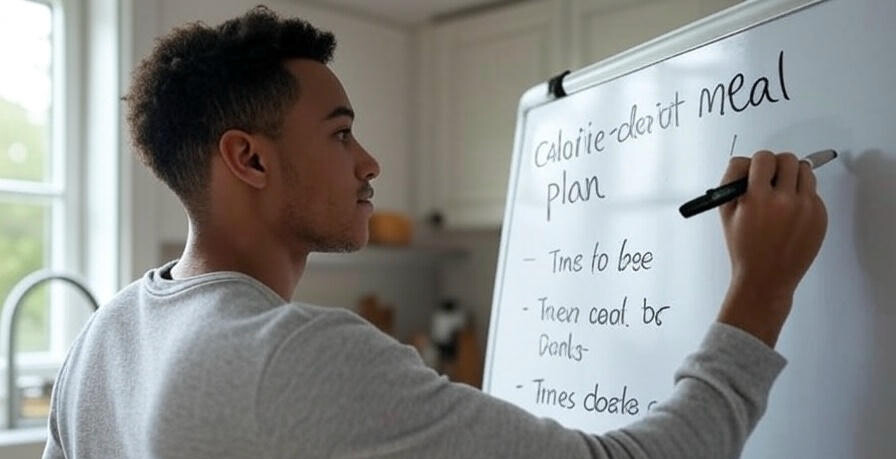How to Create an Effective Calorie Deficit Meal Plan at Home
Creating a successful calorie deficit meal plan is the foundation of sustainable weight loss. Whether you’re just starting your fitness journey or looking to optimize your current approach, this comprehensive guide will help you develop a personalized meal planning strategy that fits your lifestyle and goals.
Quick Navigation: Learn everything from calculating your calorie needs to meal prep strategies. This guide covers practical tips for creating a calorie deficit meal plan that you can easily follow at home.
Understanding Calorie Deficit for Weight Loss
A calorie deficit occurs when you consume fewer calories than your body burns throughout the day. This fundamental principle is essential for weight loss, as it forces your body to use stored fat for energy. Creating an effective calorie deficit meal plan requires understanding your body’s energy needs and making informed food choices.
How Much Calorie Deficit Do You Need?
| Weight Loss Goal | Weekly Deficit | Daily Deficit | Expected Loss |
|---|---|---|---|
| Slow & Steady | 3,500 calories | 500 calories | 1 lb per week |
| Moderate | 5,250 calories | 750 calories | 1.5 lbs per week |
| Aggressive | 7,000 calories | 1,000 calories | 2 lbs per week |
Expert Tip: The Mayo Clinic recommends starting with a moderate 500-750 calorie deficit for sustainable weight loss results.
Step-by-Step Guide to Creating Your Calorie Deficit Meal Plan
Step 1: Calculate Your Daily Calorie Needs
Before creating your calorie deficit meal plan, determine your Total Daily Energy Expenditure (TDEE). This includes your Basal Metabolic Rate (BMR) plus calories burned through daily activities and exercise.
| Activity Level | Description | BMR Multiplier |
|---|---|---|
| Sedentary | Little to no exercise | 1.2 |
| Lightly Active | Light exercise 1-3 days/week | 1.375 |
| Moderately Active | Moderate exercise 3-5 days/week | 1.55 |
| Very Active | Hard exercise 6-7 days/week | 1.725 |
| Extremely Active | Very hard exercise, physical job | 1.9 |
Step 2: Choose Your Macronutrient Distribution
A balanced calorie deficit meal plan should include proper ratios of proteins, carbohydrates, and fats. Here’s a recommended distribution for weight loss:
| Macronutrient | Percentage | Grams per lb body weight | Primary Benefits |
|---|---|---|---|
| Protein | 30-35% | 0.8-1.2g | Muscle preservation, satiety |
| Carbohydrates | 35-45% | 1.0-1.5g | Energy, brain function |
| Fats | 20-30% | 0.3-0.5g | Hormone production, absorption |
Sample Calorie Deficit Meal Plan Templates
These meal plan templates are designed for different calorie targets. Adjust portions based on your specific needs and health requirements.
1200-Calorie Daily Meal Plan
| Meal | Food Items | Calories | Protein (g) |
|---|---|---|---|
| Breakfast | Greek yogurt (1 cup) + berries (1/2 cup) + almonds (10) | 280 | 20 |
| Lunch | Grilled chicken salad (4oz) + mixed greens + olive oil (1 tbsp) | 320 | 35 |
| Snack | Apple + peanut butter (1 tbsp) | 180 | 4 |
| Dinner | Baked salmon (4oz) + steamed broccoli + quinoa (1/2 cup) | 420 | 32 |
| Total | – | 1200 | 91 |
1500-Calorie Daily Meal Plan
| Meal | Food Items | Calories | Protein (g) |
|---|---|---|---|
| Breakfast | Oatmeal (1 cup) + banana + protein powder (1 scoop) | 380 | 28 |
| Lunch | Turkey wrap + avocado + vegetables | 420 | 25 |
| Snack 1 | Greek yogurt + nuts | 200 | 15 |
| Dinner | Lean beef stir-fry + brown rice + vegetables | 450 | 30 |
| Snack 2 | Cottage cheese + berries | 150 | 12 |
| Total | – | 1500 | 110 |
Essential Foods for Your Calorie Deficit Meal Plan
High-Protein, Low-Calorie Foods
| Food Item | Serving Size | Calories | Protein (g) | Benefits |
|---|---|---|---|---|
| Chicken Breast | 4 oz | 185 | 35 | Lean protein, versatile |
| Greek Yogurt | 1 cup | 130 | 23 | Probiotics, calcium |
| Egg Whites | 4 large | 68 | 14 | Pure protein, no fat |
| White Fish | 4 oz | 125 | 28 | Omega-3, low calories |
| Cottage Cheese | 1 cup | 220 | 28 | Casein protein, filling |
Low-Calorie, High-Volume Foods
| Food Category | Examples | Calories per Cup | Key Nutrients |
|---|---|---|---|
| Leafy Greens | Spinach, kale, lettuce | 7-20 | Vitamins A, C, K, folate |
| Cruciferous Vegetables | Broccoli, cauliflower, Brussels sprouts | 25-55 | Fiber, vitamin C, antioxidants |
| Water-Rich Fruits | Watermelon, strawberries, cantaloupe | 45-60 | Vitamin C, potassium, hydration |
| Zucchini & Squash | Yellow squash, zucchini noodles | 20-35 | Vitamin A, fiber, potassium |
Meal Prep Strategies for Calorie Deficit Success
Effective meal preparation is crucial for maintaining your calorie deficit meal plan. Harvard Health Publishing emphasizes that meal prep can significantly improve diet quality and weight management outcomes.
Weekly Meal Prep Schedule
| Day | Prep Task | Time Required | Foods to Prepare |
|---|---|---|---|
| Sunday | Protein batch cooking | 2-3 hours | Chicken, fish, lean beef, hard-boiled eggs |
| Sunday | Carb preparation | 1 hour | Rice, quinoa, sweet potatoes, oats |
| Sunday | Vegetable prep | 45 minutes | Wash, chop, portion vegetables |
| Wednesday | Mid-week refresh | 30 minutes | Fresh salads, fruit portions |
Common Mistakes to Avoid in Calorie Deficit Meal Planning
Important: Avoiding these common pitfalls will help ensure your calorie deficit meal plan remains sustainable and effective for long-term weight loss success.
Top 5 Meal Planning Mistakes
| Mistake | Why It Happens | Solution | Impact on Results |
|---|---|---|---|
| Too Aggressive Deficit | Wanting quick results | Aim for 1-2 lbs per week max | Prevents muscle loss, metabolic damage |
| Ignoring Protein Needs | Focus only on calories | Prioritize 0.8-1.2g per lb body weight | Maintains muscle mass during weight loss |
| Eliminating Food Groups | All-or-nothing mentality | Include all macronutrients in moderation | Improves adherence and nutrient intake |
| Not Tracking Accurately | Estimating portions | Use food scale and measuring tools | Ensures actual calorie deficit |
| Perfectionism | Fear of making mistakes | Allow 80/20 approach for flexibility | Promotes long-term sustainability |
Adjusting Your Calorie Deficit Meal Plan Over Time
As you progress in your weight loss journey, your calorie deficit meal plan will need adjustments. Your metabolism adapts, and your calorie needs change as your body composition improves.
When and How to Adjust Your Plan
| Time Period | Expected Changes | Adjustment Strategy | Monitoring Metrics |
|---|---|---|---|
| Weeks 1-2 | Initial water weight loss | Stay consistent with plan | Daily weigh-ins, measurements |
| Weeks 3-4 | Steady fat loss begins | Monitor progress, minor tweaks | Weekly averages, progress photos |
| Weeks 5-8 | Possible plateau | Reduce calories by 100-200 or increase activity | Body fat percentage, strength levels |
| Week 9+ | Metabolic adaptation | Consider diet breaks or refeed days | Energy levels, sleep quality, mood |
Technology Tools for Calorie Deficit Meal Planning
Modern technology can significantly simplify your calorie deficit meal plan management. Stay updated with the latest technology trends that can support your weight loss journey.
Recommended Apps and Tools
| Tool Category | Recommended Options | Key Features | Cost |
|---|---|---|---|
| Calorie Tracking | MyFitnessPal, Cronometer | Barcode scanning, large food database | Free/Premium |
| Meal Planning | Eat This Much, PlateJoy | Automated meal plans, shopping lists | Subscription |
| Recipe Nutrition | Recipe analyzer tools | Calculate nutrition for home recipes | Free |
| Progress Tracking | Happy Scale, Libra | Weight trend analysis, goal setting | Free |
Troubleshooting Your Calorie Deficit Meal Plan
Remember: Creating a successful calorie deficit meal plan is a learning process. Be patient with yourself and make adjustments based on your body’s response and lifestyle needs.
Common Challenges and Solutions
| Challenge | Possible Causes | Immediate Solutions | Long-term Strategies |
|---|---|---|---|
| Constant Hunger | Insufficient protein/fiber, too aggressive deficit | Increase protein intake, add volume foods | Moderate deficit, focus on satiety |
| Energy Crashes | Poor meal timing, blood sugar fluctuations | Eat regular meals, balance macronutrients | Optimize meal timing around activities |
| Social Eating Pressure | Lack of planning for social events | Plan ahead, communicate boundaries | Develop flexible strategies for social situations |
| Weight Loss Plateau | Metabolic adaptation, inaccurate tracking | Reassess calorie needs, increase accuracy | Implement diet breaks, vary approach |
Long-term Success with Your Calorie Deficit Meal Plan
Creating a sustainable calorie deficit meal plan is about more than just losing weight—it’s about developing healthy habits that last a lifetime. Research from the National Weight Control Registry shows that successful weight maintainers share common strategies including consistent meal planning and regular monitoring.
Success Tip: Focus on creating a calorie deficit meal plan that you can realistically follow for months, not just weeks. Sustainability is the key to long-term weight management success.
Building Lasting Habits
| Habit Category | Daily Actions | Weekly Actions | Monthly Reviews |
|---|---|---|---|
| Planning | Review tomorrow’s meals | Plan and prep for the week | Assess what’s working and what isn’t |
| Tracking | Log all food intake | Review weekly calorie averages | Analyze trends and patterns |
| Flexibility | Make smart substitutions | Allow for social meals | Adjust plan based on lifestyle changes |
| Mindfulness | Eat without distractions | Practice mindful grocery shopping | Reflect on relationship with food |
Conclusion: Your Path to Calorie Deficit Success
Creating an effective calorie deficit meal plan doesn’t have to be complicated or restrictive. By following the strategies outlined in this guide, you can develop a sustainable approach to weight loss that fits your lifestyle and preferences.
Remember that successful weight loss is a gradual process that requires patience, consistency, and flexibility. Your calorie deficit meal plan should evolve with your needs and circumstances, always prioritizing your health and well-being over rapid results.
Start with small, manageable changes and gradually build upon your success. With proper planning, realistic expectations, and the right tools, you can create a calorie deficit meal plan that not only helps you lose weight but also improves your overall health and relationship with food.
For more health and wellness tips, visit our health section. Stay updated with the latest news and information by visiting our homepage.
Disclaimer: This information is for educational purposes only and should not replace professional medical advice. Consult with a healthcare provider or registered dietitian before starting any new diet plan, especially if you have underlying health conditions.



